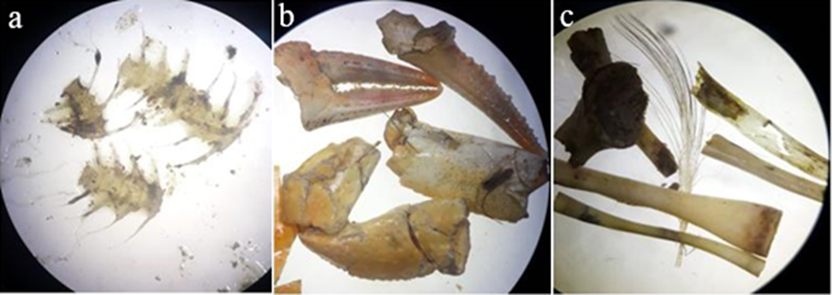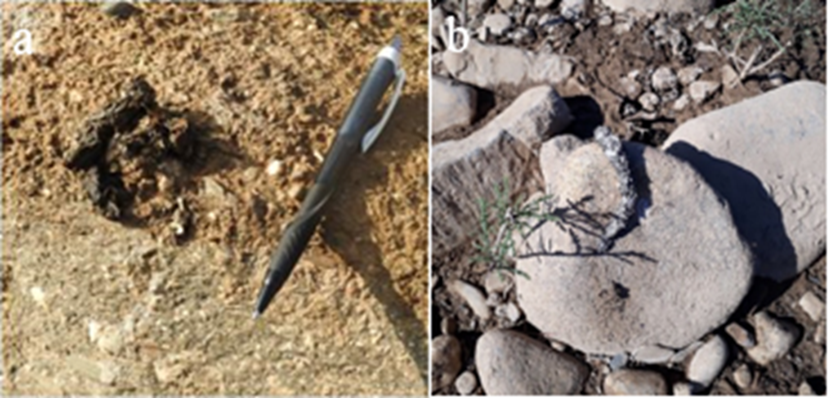IUCN/SSC Otter Specialist Group Bulletin

©IUCN/SCC Otter Specialist Group
Citation: Mahamoud, A., Hilmi, M., Ondiba, M., El Agbani, M.A., and Qninba, A. (2024). Freshwater Crab (Potamon algeriense) in the Diet of the Eurasian Otter (Lutra lutra) in the Lower Valley of Beht River in Morocco. IUCN Otter Spec. Group Bull. 41 (2): 115 - 123
Freshwater Crab (Potamon algeriense) in the Diet of the Eurasian Otter (Lutra lutra) in the Lower Valley of Beht River in Morocco
Abdallah Mahamoud1*, Mohammed Hilmi1, Melvin Ondiba2, Mohammed Aziz El Agbani1, and Abdeljebbar Qninba1
1Laboratory of Geo-Biodiversity and Natural Heritage (GEOBIO), Scientific Institute,
Mohammed V University in Rabat, Morocco
2Laboratory of Biodiversity, Ecology and Genome, Faculty of Sciences,
Mohammed V University in Rabat, Morocco
*Corresponding Author Email: amc1997mbeni@.com
Received 18th December 2023, accepted 19th January 2024
Abstract: The Eurasian otter (Lutra lutra) is a carnivorous, semi-aquatic species found in Morocco’s wild fauna. In 2020, a search for signs of presence combined with the collection of spraints was carried out in the lower valley of the main course of the Beht river. The aim of the study was to confirm that the otter does indeed frequent the area and to study the species diet. Surveys were carried out during which thirty-one spraints were collected, processed and analyzed in the laboratory. Several signs of otter presence in the lower valley of Beht river were discovered. This work has highlighted an originality (not reported to our knowledge for the diet of the Eurasian otter): the consumption of freshwater crab (Potamon algeriense), especially during dry periods.
Keywords: Eurasian otter, diet, freshwater crab (Potamon algeriense), Beht river
INTRODUCTION
The Eurasian otter Lutra lutra (Linnaeus, 1758) is a carnivorous semi-aquatic mammal widely distributed across most of Morocco's hydrologic systems (Libois et al., 2015). Surveys carried out in 1983, 2011, 2012 and 2013 demonstrated its presence in the North, Middle and High Atlas, Atlantic coastal areas and pre-Saharan areas of Morocco (Delibes et al., 2012; Libois et al., 2012; Macdonald and Mason, 1984; Riesco et al., 2020). From 2009 to 2011, a study on the diet and trophic strategy of the otter was carried out along the Beht river (33°51'14.1 "N 5° 55'26.3 "W upstream and 33°44'00.4 "N 5°56'56.28 "W downstream) to highlight the species' adaptive capacities and predatory strategies over the seasons, depending on the food resources (Libois et al., 2015). This study focused on the general definition of the otter's diet and its seasonal variation, and did not include any specific features of its diet. As part of the study that we carried out on the species, we found evidence of its presence in the study area and we were interested in studying its diet and its specificities. In this article, we show the specific nature of the consumption of freshwater crab (Potamon algeriense) by the Eurasian otter. Our study was based on the analysis of spraints collected in the field and on direct observations made during field missions.
MATERIALS AND METHODS
Study Area
Beht river is one of the main wadis in Morocco’s Atlantic region. It rises on the western edge of the Middle Atlas Course and drains in the northern edge of central Morocco as far as the Gharb region, where it joins the Wadi Sebou (Laabidi et al., 2016). The study area extends from the gorges at Amçal n'Ayt Brahim (33°51'14.1"N 5°55'26.3"W) on the upstream to the confluence of the Beht river with the Rherga river on the downstream (33°44'00.4"N 5°56'56.28"W). This study area is located between two dams on Beht river, namely the Ouljet Essoltane dam upstream and the El Kansera dam downstream. It extends over a distance of approximately 20 kilometres between the two dams, at an altitude of between 145 m and 152 m. The climate is semi-arid Mediterranean (300 mm to 400 mm) (Libois et al., 2015).
The selected study area is characterized by habitat units (Fig. 1) as follows:
- The main bed of Beht river with an average flow rate and a depth ranging from a few centimetres to a maximum of 2 metres.
- Two islands, one upstream and one downstream of the study area.
- The riparian vegetation, discontinuous in some areas and dominated by woody vegetation consisting of tamarisk (Tamarix gallica), wild tobacco (Nicotiana glauca) and milk thistle (Silybum marianum) on the silty substrates, and chaste trees (Vitex agnus-castus) and oleander (Nerium oleander) on the rocky areas.
- Beyond the riparian area, almost the entire area is farmland, with the exception of two plots that have retained their natural appearance.
The following animals are species of conservation interest that have been recorded in the study area and its immediate surroundings: the Brown-throated Martin (Riparia paludicola mauritanica), the Lanner Falcon (Falco biarmicus erlangeri), the Peregrine Falcon (Falco peregrinus brookei), the Freshwater Crab (Potamon algeriense), three species of Bivalves (Unio gibbus, Unio foucauldianus and Potamida littoralis), two species of wild fish (Luciobarbus maghrebensis and Carasobarbus fritchii) and the Moorish Tortoise (Testudo graeca) (Hilmi et al. 2023).
Otter Surveys
Due to the otter’s nocturnal behavior, detecting its presence and assessing its distribution can only be done by searching for certain indicators. This is because the species is very difficult to observe; however, it leaves marks in its home range that are relatively easy to spot, the most reliable being spraints and footprints.
During 2020, we carried out field missions over eight (8) months, with one or two missions per month lasting one to three days (except during the months of March, April, May, and August due to the COVID 19 pandemic), searching for signs of otter presence (spraints, footprints and burrows).
Surveys were carried out at seven (7) pre-selected stations spread along the study area (2 to 2.5 km apart) in accordance with an inventory protocol validated by the International Union for Conservation of Nature (Reuther et al., 2000), which recommends selecting a sampling sector every x kilometres of watercourse, with this distance (x) varying according to the desired precision of the inventory, so that, at the scale of the study area, all of its sectors are more or less equally distributed (Varanguin and Sirugue, 2008). The protocol was adapted to the context of the study area by increasing the number of survey points per kilometre compared with the standard kilometres of the protocol. We searched for signs of otter presence along the banks of the Beht river . At each station, the survey was carried out on both banks, as far as possible over a distance of around 300 m upstream and 300 m downstream of the station reference point, as indicated in the protocol. The geographical coordinates of each station, together with their altitudes, are shown in Figure 2.
Otter spraints (faeces) are unique and characterize this species. They contain solid elements, fish scales and bones, small bones, clearly visible in a shapeless mass. They are deposited in plain view on solid surfaces such as stones, pebbles, concrete structures, etc. As they gradually dry out, they adhere to the surface on which they were deposited, sometimes on the vertical edges of rocks, and can stay in place for several weeks (Thiriet and Mercier, 2006). The spraints observed in the study area were divided into two categories:
- Fresh spraints: They appear colored black or shiny brown-black with a Strong smell of slightly musky fish oil (Figure 3).
- Old or dry spraints: They appear dry and greyish to whitish with less odour as compared to fresh spraints (Figure 3) (Cognet and Veaux, 2019).
Treatment of Faeces
In the missions conducted, all the spraints observed were collected in freezer bags and transported to the laboratory for analysis. The collection of the spraints is summarized in Table 1. Once in the laboratory, the spraints were soaked in water for 48 hours, then separated from their substrate by sieving through a 1 mm sieve with tap water and then dried in an oven.
| Table 1: Summary of the spraints collected at each station. | |
| Station Number | Number of Spraints Collected |
| 01 | 8 |
| 02 | 12 |
| 03 | 0 |
| 04 | 2 |
| 05 | 0 |
| 06 | 8 |
| 07 | 2 |
| Total | 31 |
Sorting was carried out with forceps by spreading the samples in small streaks on a petri dish under strong lighting of a binocular magnifying glass. This treatment technique was also used by Libois et al. (1987) in Brittany inland to investigate the diet of otter populations. The occurrence and frequency of occurrence of each zoological group was then determined.
RESULTS AND DISCUSSION
The results of the otter’s overall diet obtained after the treatment of the thirty-one (31) collected spraints are presented in Figure 4.
These results show that the otter population in our study area has a classic diet, for the majority fish, but also including prey from other zoological groups (birds and crustaceans). We noticed the specific presence of the freshwater crab Potamon algeriense in the spraints, especially during the summer period (end of June and July) when fish are scarce due to temporary drying of the Beht river (Fig. 5).

The study of otter diet carried out by Libois et al. (2015) along Beht river generally showed that otters in Morocco have a “classic” and highly diversified diet, with fish predominating. The results obtained from processing the samples taken in the field correspond to our previous conclusions. Our study revealed a significant abundance of fish, but also noted the presence of crustaceans and birds.
During our most recent observations in July 2020, we noted a slight predominance of the remains of freshwater crabs belonging to the Potamidae family (Potamon algeriense) as well as birds in the spraints collected. This situation is probably due to a considerable reduction in fish stocks, forcing the otter to feed according to the resources available in its environment. The consumption of freshwater crabs by otters is further proof that they hunt by favoring the least effort: the amount of energy obtained by consuming a prey item must exceed that required to capture it (Bouchardy, 1986). Consequently, the prey hunted is not necessarily the largest, but rather the most abundant and/or the easiest to catch (Lanszki et al., 2001). It is therefore logical for otters to choose smaller, slower-moving prey, such as freshwater crabs, in order to save energy, especially that they do not stalk and hunt mainly by sight, often by stealth attacks from behind (Bouchardy, 1986).
The consumption of freshwater crabs Potamon algeriense by otters has not been reported before in Morocco, making our discovery a major contribution to our understanding of the ecology of this species. The current habitats in the study area seem relatively favorable for presence of the species, since they offer areas of shelter, food (fish and other prey) and water, three elements that are essential for its survival (Sordello, 2012).
CONCLUSION
Following the otter survey missions carried out in the lower Beht river , several signs of otter presence were recorded confirming that the Eurasian otter (Lutra lutra) is indeed present in the defined study area. Footprints were observed and spraints were also collected from the study area. The data revealed that the otter consumes mainly fish, which is traditionally known. However, we found that during the dry period when the Beht river is temporarily dry, birds and the freshwater crab, a crustacean that has never been mentioned in the literature is also an otter prey species. Here we have seen how the Eurasian otter has adapted to its aquatic environment by opting to prey on freshwater crabs. This adaptation demonstrates not only its ability to exploit available resources efficiently, but also the fragile balance that exists within the ecosystems of Beht river . Our findings concerning the consumption of freshwater crabs by the Eurasian otter have the merit of reinforcing the evidence of the considerable plasticity of this species in its diet.
Acknowledgements: We express our gratitude to Potasse de Khemisset for their financial support of our fieldwork and equipment purchase for our study, as part of their scientific cooperation with the Institut Scientifique. We would like to express our gratitude to the Oued Beht riverside for their cooperation, valuable advice, and generosity. We also extend our thanks to all those who contributed to the production of the manuscript.
REFERENCES
Bouchardy, C. (1986). La loutre. Sang de la Terre, París, 174pp. ISBN: 978-2869850033
Cognet, C., Veaux, A. (2019). Prospecting for the presence of the European Otter between Pierre-Bénite and Grigny. Rapport d’Étude b. Grigny: SMIRIL. Archives
numériques du SMIRIL
https://www.smiril.fr/wp-content/uploads/2019/12/Suivi_SMIRIL_Loutre_2019.pdf
Delibes, M., Calzada, J., Clavero, M., Fernández, N., Gutiérrez-Expósito, C., Revilla, E., Roman, J. (2012). The Near Threatened Eurasian otter Lutra lutra in Morocco: No sign of recovery. Oryx, 46: 249 - 252 . https://doi.org/10.1017/S0030605311001517
Georgiev, D., Stoycheva, S. (2006). Freshwater crabs preyed on by the Eurasian Otter Lutra lutra in a river habitat of southern Bulgaria. Hystrix : the Italian Journal of Mammalogy, 17(2). https://doi.org/10.4404/hystrix-17.2-4370
Hilmi, M., Mahamoud, A., El Agbani, M, A., Qninba, A. (2023). Biodiversity and ecological values of a section of the lower Oued Beht valley located between the El Kansera and Ouljet Essoltane dam reservoirs (Khémisset Province -Morocco). Bulletin de l’Institut Scientifique, Rabat, Section Sciences de la Vie, 44: 7-17. https://www.researchgate.net/publication/372159390
Laabidi, A., Gourari, L., El Hmaidi, A. (2016). Sedimentology and Geochemistry of Recent Alluvium of the Wadi Beht Mean (Furrow South Western Rif, Morocco): Dynamics of Implementation and Hydrological and Climatic Meaning. IJERA (Int. Journal of Engineering Research and Applications), 6(5): 35-42. https://ijera.com/papers/Vol6_issue5/Part%20-%206/H060506035042.pdf
Lanszki, J., Körmendi, S., Hancz, C., Martin, TG (2001). Examination of some factors affecting selection of fish prey by otters (Lutra lutra) living by eutrophic fish ponds. Journal of Zoology, 255(1): 97‑103. https://doi.org/10.1017/S0952836901001145
Libois, R., Fareh, M., Brahimi, A., Rosoux, R. (2015). Diet and seasonal trophic strategy of the European Otter, Lutra lutra, in Middle Atlas, Morocco. Revue d’Ecologie (Terre et Vie), 70 (4): 314-327. https://www.researchgate.net/publication/282702049
Libois, R., Rosoux, R., Fareh, M. (2012). Evolution of the distribution of the European otter (Lutra lutra) in Morocco. Abstracts 2nd International Colloquium on the Management and Preservation of Water Resources, Meknes 10-12 May 2012, p. 41.
Libois, RM, Hallet Libois, C., Lafontaine, L. (1987). The diet of the otter (Lutra lutra) in inland Brittany. Revue d’Ecologie (Terre et Vie), 42(2) : 135-144. https://www.persee.fr/doc/revec_0249-7395_1987_num_42_2_5399
Macdonald, S.M., Mason, C.F. (1984). Otters in Morocco. Oryx, 18(3): 157‑159. https://doi.org/10.1017/S0030605300019013
Reuther, C., Dolch, D., Green, R., Jahrl, J., Jefferies, D., Krekemeyer, A., Kucerova, M., Madsen, A.B., Romanowski, J., Roche, K., Ruiz-Olmo, J., Teubner, J. & Trindade, A. (2000). Surveying and Monitoring Distribution and Population Trends of the Eurasian Otter (Lutra lutra) - Guidelines and Evaluation of the Standard Method for Surveys as recommended by the European Section of the IUCN/SSC Otter Specialist Group. Habitat 12, Hankensbüttel, 148 pp.
Riesco, M., Delibes, M., Calzada, J., Esquivias, J., Qninba, A., Clavero, M. (2020). Desert otters: Distribution, habitat use and feeding ecology in arid rivers of Morocco. Journal of Arid Environments, 178: 4-9. https://doi.org/10.1016/j.jaridenv.2020.104165
Sordello R. (2012). Synthèse bibliographique sur les traits de vie de la Loutre d'Europe (Lutra lutra (Linnaeus, 1758)) relatifs à ses déplacements et à ses besoins de continuités écologiques. [Bibliographic summary of the life history characteristics of the European otter (Lutra lutra (Linnaeus, 1758)) in relation to its movements and its needs for ecological continuity]. Natural Heritage Service of the National Museum of Natural History. Paris. p.19. https://www.trameverteetbleue.fr/sites/default/files/syntheses-bibliographiques-especes/131219_loutre_europe_fev2012.pdf
Thiriet, J., Mercier, L. (2006). Indices récents de la présence de la Loutre d’Europe Lutra lutra (Linnaeus, 1758) (Carnivora, Mustelidae) dans le nord du Haut-Rhin (France) [Recent evidence of the presence of the European otter Lutra lutra (Linnaeus, 1758) (Carnivora, Mustelidae) in the north of Haut-Rhin (France)]. Bull. Soc. Hist. Naturelle et d’Ethnographie de Colmar, 67: 77-78. https://www.museumcolmar.org/bulletin/indices-recents-presence-loutre-deurope-lutra-lutra-linnaeus-1758-carnivora-mustelidae
Varanguin, N., Sirugue, D. (2008). Vers une reconquête des rivières par la Loutre en Bourgogne [Towards a reconquest of the rivers by the Otter in Burgundy]. Bourgogne-Nature, 8: 205-227. https://bfcnature.fr/produit/n8-les-vertebres/
Résumé: Le Crabe d’Eau Douce (Potamon algeriense) dans le Régime Alimentaire de la Loutre Eurasiennne (Lutra lutra) de la basse Vallée du Wadi Beht au Maroc
La loutre eurasienne (Lutra lutra) est une espèce carnivore semi-aquatique présente dans la faune sauvage du Maroc. En 2020, une recherche d’indices de présence combinée à un recueil d'épreintes a été réalisée dans la basse vallée du cours principal de l’oued Beht. Le but de l’étude était de confirmer que la loutre fréquente effectivement la zone et d’étudier le régime alimentaire de l’espèce. Des enquêtes ont été réalisées au cours desquelles trente et une épreintes ont été collectées, traitées et analysées en laboratoire. Plusieurs indices de présence de loutres dans la basse vallée de Wadi Beht ont été découverts. Ce travail a mis en évidence une originalité (à notre connaissance, non rapportée en ce qui concerne le régime alimentaire de la loutre eurasienne): la consommation de crabe d’eau douce, notamment en période de sécheresse.
Revenez au dessus
Resumen: Cangrejo de Agua Dulce (Potamon algeriense) en la Dieta de la Nutria Eurasiática (Lutra lutra) en el Valle Inferior de Wadi Beht, Marruecos
La nutria Eurasiática (Lutra lutra) es una especie carnívora semi-acuática que forma parte de la fauna silvestre de Marruecos. En 2020, fue llevada a cabo una búsqueda de signos de presencia combinada con la colecta de fecas, en el valle inferior del curso principal del Wadi Beht. El objetivo del estudio fue confirmar que la nutria en efecto frecuenta el área, y estudiar la dieta de la especie. Los relevamientos fueron llevados a cabo, colectando treinta y una fecas, que fueron procesadas y analizadas en el laboratorio. Fueron descubiertos varios signos de presencia de nutria en el valle inferior de Wadi Beht. Este trabajo ha destacado una originalidad (no informada, según nuestro conocimiento, para la dieta de la nutria Europea): el consumo de cangrejo de agua dulce, especialmente durante períodos secos.
Vuelva a la tapa
الخلاصة
سرطان المياه العذبة (Potamon algeriense) في النظام الغذائي كلب الماء الأوروبي (Lutra lutra) في وادي بهت.
كلب الماء الأوروبي(Lutra lutra) هو نوع من الحيوانات شبه المائية آكلة اللحوم الموجودة في الحيوانات البرية في المغرب. في عام 2020، تم إجراء بحث عن علامات التواجد بالإضافة إلى المجرى الرئيسي لوادي بهت. كان الهدف من الدراسة هو التأكد من أن كلب الماء موجود بالفعل على المنطقة ودراسة النظام الغذائي. تم إجراء مسوحات تم خلالها جمع إحدى وثلاثين عضة وتحليلها في المختبر. تم اكتشاف العديد من الدلائل على وجود كلب الماء في الوادي بهت. وقد سلط هذا العمل الضوء على شيء أصيل (لم يتم الإبلاغ عنه على حد علمنا بالنسبة للنظام الغذائي كلب الماء الأوروبي): استهلاك سرطان المياه العذبة (Potamon algeriense)، خاصة خلال فترات الجفاف.
العودة إلى البداية








